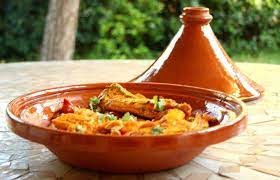Ceramic and clay vessels
Moroccan Traditionally cuisine
One of the reasons for its importance is its remarkable
number and diversity of influences. their rule of Roman Africa. Ceramic tagines
are exquisite examples of Moroccan
In Moroccan dishes, one can trace the country’s long history
of colonizers and immigrants artisanship and many are show pieces as well as
functional cooking vessels. who have left their mark in more than one way.
Although tagines are traditionally made of clay or ceramic, some Western cookware Firstly, the Berbers influences, still exists today in the staple dishes like tagine and companies are now making tagines from other materials. Some of these may only be couscous. The Arab invasion brought new spices, nuts and dried fruits, and the sweet intended to be used as decorative serving dishes.
and sour combinations that we see in dishes like tagine with
dates and lamb. The A tangia is a large earthenware vase- shaped hollow pot
with a round base, an open Moors introduced olives, olive juice and citrus
while the Jewish-Moors left behind their neck and a handle on each side. (See
the picture on this page.) The meat dish will be sophisticated preserving
techniques that we see in the frequent use of preserved lemons, placed inside
and the mouth sealed before placing the vessel between slow- glowing pickles,
etc. The Ottoman Empire introduced barbeque (kebabs) to Moroccan cuisine. The coals.
A tagine consist of two parts, a circular shallow dish used for both cooking
French colony, although short-lived compared to reign of some of these other
empires, and serving, while the top of the tagine is distinctively shaped into
a rounded dome
left behind a culture of cafes, pastries, and even wine. or
cone.
Over time, cooks in the kitchens of the four royal cities
(Fez, Marrakesh, Meknes, and The word “tagine” also refers to the succulent
dish which is slow- cooked inside the Rabat) have developed and perfected the
dishes that blend each of these distinct tastes. cooking vessel. Typically, a
tagine is a rich stew of meat, chicken, or fish, and most Every Moroccan dish
has its place in society and varies with the market, the season, and often
includes vegetables or fruit. Vegetables can also be cooked alone. the region.
Cooking with a tangia
Moroccans would take their tangia to an oven adjacent to a
hamam, a Turkish bath house, where it would slow-cook in the ashes from the
fire used for heating. It is also known as a bachelor’s stew, he prepares the
dish, puts it in the tangia and have it cooked in the fire while he is visiting
the hamam.
This is such an easy family dish and little or no cooking
skills are required. To create this tasty dish, simply put all the ingredients
into the vessel, stir until it is properly mixed, sit back, relax and wait.
TRADITIONAL METHOD
Put all the
ingredients and spices into the tangia, cover the opening with a circle of
parchment paper that is larger than the opening. Cover the parchment paper with
a layer of aluminium foil, wrapping it snugly over the mouth of the tangia by
pressing it around the rim to seal. Pierce the foil in four places with a fork.
Bury the pot in hot ashes from a fire, slow-cook for 5 – 6 hours till the meat
is soft and tender and fall off the bone.
OVEN METHOD USING A TANGIA
Prepared the dish in the same way as above, place the tangia
in a cold oven, turn the heat to 140˚C and leave the tangia for 5 – 6 hours.
Ensure that you add additional liquid to the dish.
COOKING WITHOUT A TANGIA
Replace the tangia with an ovenproof dish, casserole or a
clay pot and slow-cook in the oven till the meat is soft. Alternatively cook on
the stovetop in a casserole or a pressure cooker to speed up the process. Why
don’t you try making the dish over a fire and make it a ‘potjie’ over the fire.
Cooking with a tagine
Tagines are primarily used to slow-cook stews and vegetable
dishes. The domed or cone-shaped lid of the tagine traps steam and returns the
condensed liquid to the pot, therefore a minimal amount of water is needed to
cook meat and vegetables to buttery-tenderness. This method of cooking is very
practical in areas where water supplies are limited or where public water is
not readily available. Unglazed clay tagines are preferred by some for the
unique earthy nuance they impart to dishes. Tagines, glazed or unglazed come in
all sizes, the smallest might hold enough food for one or two people, while the
largest can hold a meal for eight people or more.
TRADITIONAL METHOD
The traditional method of cooking with a tagine is to place
the tagine over coals. Moroccans use large bricks of charcoal specifically for
their ability to stay hot for hours.
USING A TAGINE AT HOME Use a tagine in a slow oven or
place it on a gas or electric stove top. Use the lowest heat necessary to keep
the stew simmering gently. A diffuser – a circular piece of aluminum placed
between the tagine and burner – is highly recommended to buffer and more evenly
distribute the stove’s heat.
 Reviewed by A.B
on
October 11, 2021
Rating:
Reviewed by A.B
on
October 11, 2021
Rating:








No comments: